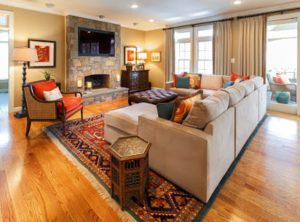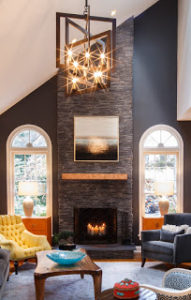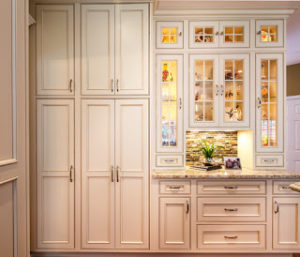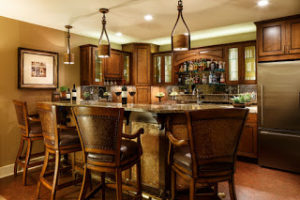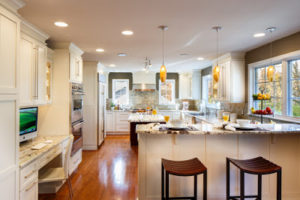“A room is like a stage. If you see it without lighting, it can be the coldest place in the world.” Such a true statement. How many of us have walked into a beautiful room that felt flat and dull? The furniture and appointments were lovely, but there was something missing. Most likely the lack of warmth and vitality were due to improper lighting. To achieve the nuance of proper lighting, you only need a little knowledge and attention to layering to turn a simple space into something magical.
Types of Lighting
There are basically three different types of interior lighting and a good lighting plan should include all three to provide a layered effect.
Ambient lighting, or general lighting, offers overall illumination that allows you to enjoy your space safely with even lighting. Ambient lighting provides essential and fundamental lighting to a room. Think of the ceiling mounted fixture in your bedroom that illuminates the whole room when you flip the switch. Other good sources of ambient lighting include recessed lights, chandeliers, flush or semi-flush mounted fixtures and even fans with light kits.
Ambient lighting on its own is not particularly pretty lighting, but is serves an important function and acts as a base layer to other types of lighting.
Task Lighting is the second layer of lighting and is necessary for performing some type of work, task or project. It is an important layer because it can soften overhead ambient lighting and offers interest by providing a light source at eye level. Think table lamps, under cabinet lighting, vanity lights and pendants. Task lighting should not be on the same switch as the ambient lighting in the room and should preferably be on a dimmer. More on dimmers to follow…
Accent lighting, the third type of lighting, is the Diva of lighting. It adds a dramatic layer to your lighting plan and should be considered with great care. Think of accent lighting as a fabulous accessory and have fun with it. It is often used to draw attention to a particular element or feature in a room, such as the warm glow of a sconce on a stone wall or cove lighting above kitchen cabinets. It is also used to showcase artwork or a decorative design motif.
Balancing Act
Balance is a key element of good design and should not be forgotten when creating a lighting plan. It is essential to employ all three types of lighting so that no one source dominates.
For example, there is nothing worse than walking into a space with a glaring overhead fixture that is the only light source in the room. It creates a flat, gray light that leaves you uninspired. Or worse yet, imagine sitting under a lamp that is so intense it reminds you of a scene from a bad spy novel.
Having a simple understanding of the three types of lighting and the importance of layering them will help you avoid these mistakes. A good balance for each type of lighting will help you create a warm and inviting space.
Everything on a Dimmer!
The final word on layering the three types of lighting is to make sure everything is on a dimmer switch. This is my hands down best advice! Many table lamps now come with a dimmable switch, but if not, try to use a 3-way bulb. It is so important to dim lights to create interest and achieve a layered light effect.
As ALA lighting expert, Eileen Naughton of Dominion Electric explains,
“Gone are the days when you could only turn a light on or off.
Dimming a light source is a simple way to create different levels of mood lighting. With the right light control you can go from a bright high energy room to a soft relaxing space.
This versatility allows greater control over the type of light you can create in each room and allows you to make adjustments based on natural light, time of day and activity at hand.
Many new homes and remodel projects place dimmers in every room, including the bathrooms, which allow greater control over the type and intensity of illumination. With dimmer switches a homeowner can create a totally custom and layered lighting plan.”
Set the Mood
Nothing impacts the mood or “feel” of a space like lighting. Humans react to light and it is essential for our well-being. Lighting is also necessary to help evoke an emotion or reaction to a space. It can be depressing or uplifting.
Take time to evaluate your living space and think about how you want it to feel. What message are you trying to convey? Do you want a high energy space or one suited for relaxation?
For example, if you are designing a kitchen or work space, you might consider bright overall lighting balanced with task lighting and bit of drama with accent lights. In a bedroom, you should focus on task and accent lighting with soft lamps or sconces to create a relaxing and calm atmosphere.
I hope this information helps you set the perfect stage for using lighting to create a warm and inviting environment. Remember to layer all three types of lighting, everything on a dimmer…and if all else fails, light some candles!
Technically Speaking
Clients often have very specific concerns about lighting beyond setting the mood or layering. Please read Technically Speaking as we address a few of the more frequently asked questions about lighting and placement.
All of the above photos are from design projects done by Salmon-Casson, Ltd.





